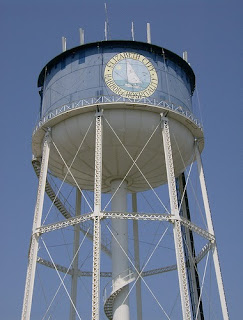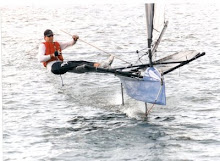Last weekend I sailed my wife's classic in a handicap race, the Hampton Roads Sunfish Challenge and Dinghy Distance Race, a 8 mile point-to-point race in the Norfolk Harbor. The course was just about all to windward, fighting a ebb tide of about a knot, in breezes of 10-15 knots. I finished in a little less than two hours, easily correcting over a Hampton One Design, a 470, a Taser, a 29er, a JY15, a Snipe, and some other assorted dinghies. The scoring was based on the US Sailing published Portsmouth Yardstick which has the moth (classic rules: 1965 vintage, 72 sq ft, etc.) at 107.1 (comparable to a Penguin at 111.5). There was no way I could lose. In fact, I beat all but one of the lasers and one of the sunfish in the water and they started 5 and 10 minutes ahead of me respectively. They were scored separately as one design fleets and didn't need the handicap, but it's interesting to note their numbers are 91.1 and 99.6. I know that US Sailing depends on clubs sending in elapsed time reports to adjust Portsmouth numbers, but for a development class such as a moth, it's almost impossible to get one number that works. The 107.1 rating is probably based on results of sundry moths sailing in pick-up fleets. Probably, the boats are old and worn and the helms are not those actively racing in the Classic Moth Boat Association. The classic moths have gotten faster and faster as hulls, sails, rigs and centerboard shapes and sizes have been put under the development pressure of CMBA competition. The fact that the top sailors racing classics are also very good dinghy sailors (including Jeff Linton, the US Sailing Rolex Yachtsman of the Year in 2008) have really spurred development. We routinely outsail Lasers when head to head.
So how would someone handicap a foiler? Below is a pic taken by Ed Salva a couple of weeks ago at Elizabeth City after the racing of the classic moth nationals. John Zseleczky is foiling past Mike Parsons (who finished 2nd in the Nationals in his Mistral behind Jeff Linton in his Mousetrap design). The Mistral seems to be the typeform of the fastest hull: narrow waterline, full beam out to 60". The CMBA bars wings with a concavity rule.

So here's the question for the day: How should a well sorted foiler be rated? Obviously, different numbers for foiling and non-foiling conditions. The RYA pegs the moth at 98 (non-foiling) and 69 (foiling.) My guess is the non-foiling is about right but the foiling number should be lower, maybe around 60. Below are some numbers to consider, comparing USSailing and RYA numbers for identical classes. In most cases, the British data indicates that boats sailing in handicap starts are slower than their US counterparts. USSailing fails to list the International Moth at all, only the "classic" moth at a too high 107.1 (the reason I won the race.)
Class USSailing RYA
505 79.8 90.2
49er 68.2 74.4
Laser 91.1 108.0
IC 79.1 90.5
Mirror 113.1 138.5
A Cat 64.5 69.0
Moth ----- 98 (non-foiling)
Moth ----- 69 (foiling)
Anybody else want to take a shot?






.jpg)

